Business
How much capital funding do small business owners need? Here's an industry breakdown
Published
11 months agoon

The average U.S. business spent $206,383 on capital expenses in 2021, but some types of businesses are more expensive to operate—and more capital-intensive than others.
Whether a business requires brick-and-mortar space, is run online, or consists of providing services is one key factor in determining the amount of capital funding needed. There are many factors that affect capital costs, including direct capital expenses like physical office space, the local real estate market, and equipment. But other factors also indirectly affect capital costs, such as licenses, insurance, professional services like accounting and legal counsel, inventory, number of employees, and marketing needs. When starting a small business, owners need a detailed accounting of their expected capital expenses and startup costs to present to investors and lenders.
Using Census Bureau data, altLINE ranked industries by their average capital expenditures in 2021 and charted the distribution of startup or acquisition capital funding needed in each one. Averages are calculated as total capital expenditures over the total number of business establishments in that industry—not just businesses that used capital funding. The charts showing how many companies in an industry required particular amounts of startup capital expenses are based on 2017 data, which is the latest available with that level of detail, and may show some differences from newer averages based on more recent economic changes.
The distribution charts are based on 2017 data, the latest available in that format, and may show some differences from newer averages based on more recent economic changes.
Keep reading to see the typical capital used to start a business as well as the average yearly cost to run a business in 18 different industries, ranked by average annual capital expenses from lowest to highest.
![]()
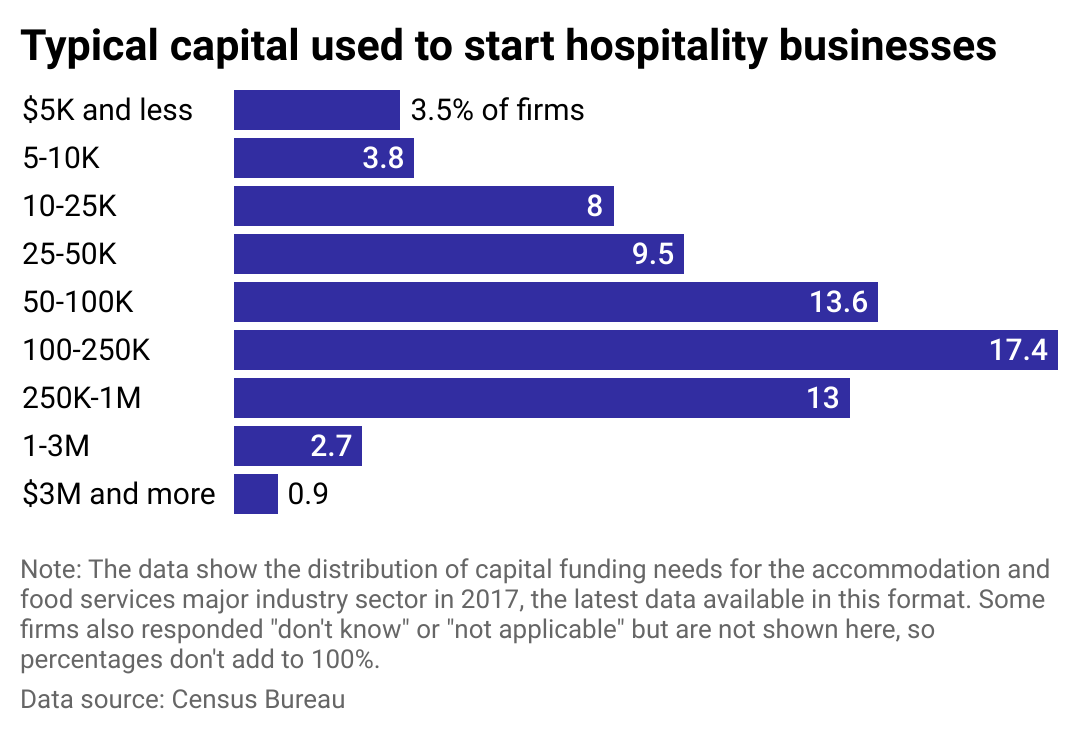
altLINE
#18. Accommodation and food services
– Average capital expenditure per establishment, 2021: $41,377
– Total 2021 capital expenditures industrywide: $25.6 billion
The accommodations and food services industry includes hotels and other types of lodging as well as restaurants and bars—all of which require a physical location. The most common range for startup costs in this industry is $100,000 to $250,000, with 17.4% of hospitality businesses reporting their startup costs fell in that range. For hotels, unique capital expenses include real estate—the location will determine the cost as well as the hotel’s ability to attract guests—and room furnishings. The more high-end the accommodations, the more the owner can charge per night.
Restaurants and bars will need to invest in specialty kitchen equipment and possibly a liquor license. The type of cuisine and dining experience can affect capital expenses as well as revenue potential.
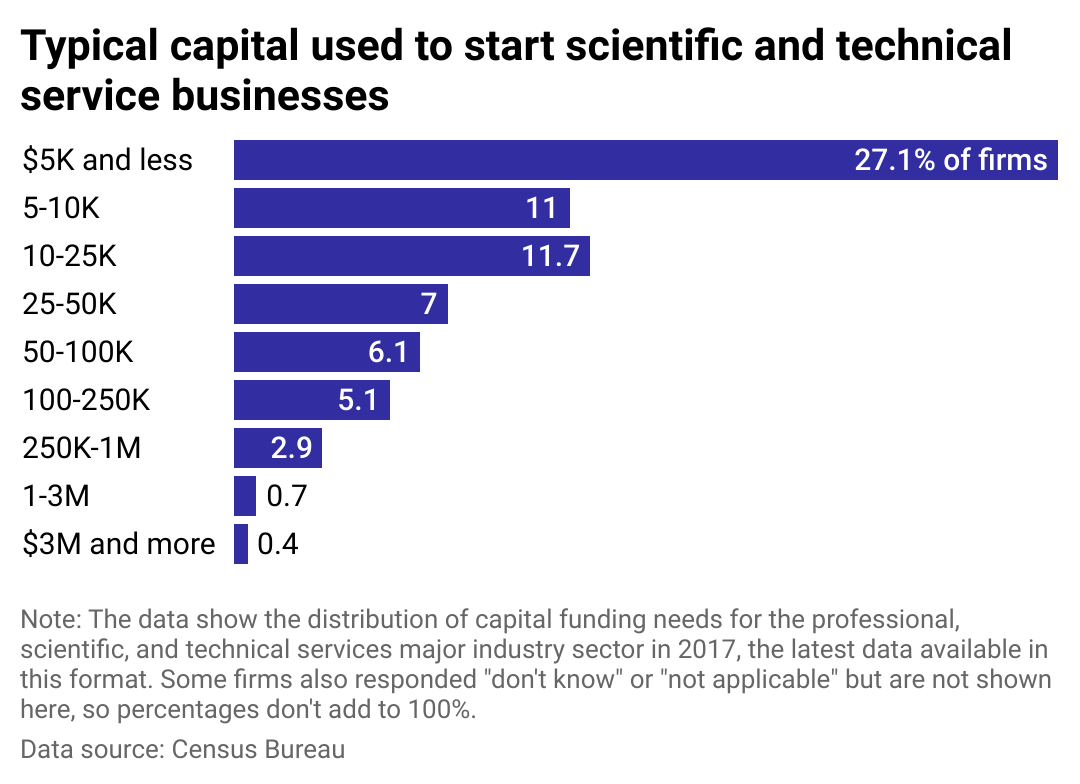
altLINE
#17. Professional, scientific, and technical services
– Average capital expenditure per establishment, 2021: $48,373
– Total 2021 capital expenditures industrywide: $30.9 billion
This is a service provider industry that requires specialized expertise and training. Professionals in this sector can include attorneys, accountants, architects, engineers, computer services, consultants, researchers, photographers, translators, and veterinarians, among others.
More than one-quarter of firms said they launched their business with $5,000 or less in capital funds. These small business owners may offer their services online, perform their services at their clients’ locations, or operate out of a brick-and-mortar location; the type of business will affect capital expenditures. This industry will likely require more investment in professional certifications and licenses. Specialized service providers may be able to operate as a one-person venture or employ a small team, which reduces capital expenditures.
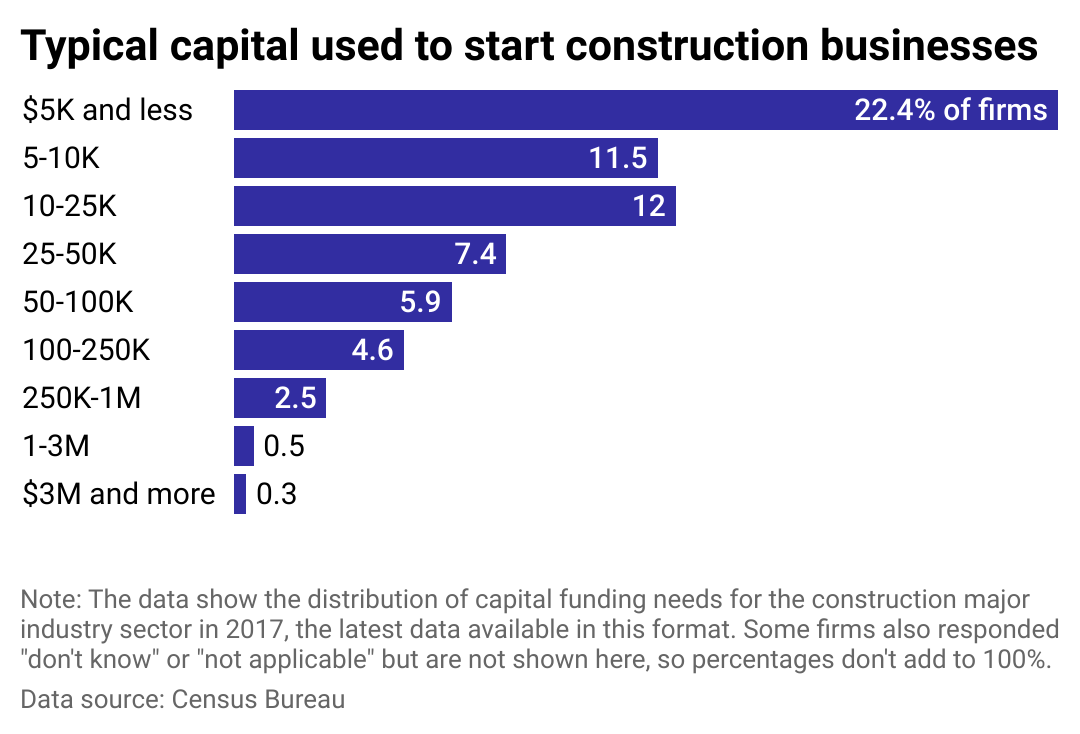
altLINE
#16. Construction
– Average capital expenditure per establishment, 2021: $57,558
– Total 2021 capital expenditures industrywide: $46.6 billion
The construction industry includes small business owners who construct buildings, engineer highways and utilities, and prepare land for new construction. Capital expenditures—which 22.4% of firms said were $5,000 or less—involve purchasing the necessary equipment and securing a place to store it when not in use. Business owners should be prepared for the ongoing capital expense of maintaining company vehicles to transport equipment and workers to job sites. A physical office space may be needed to meet with clients.
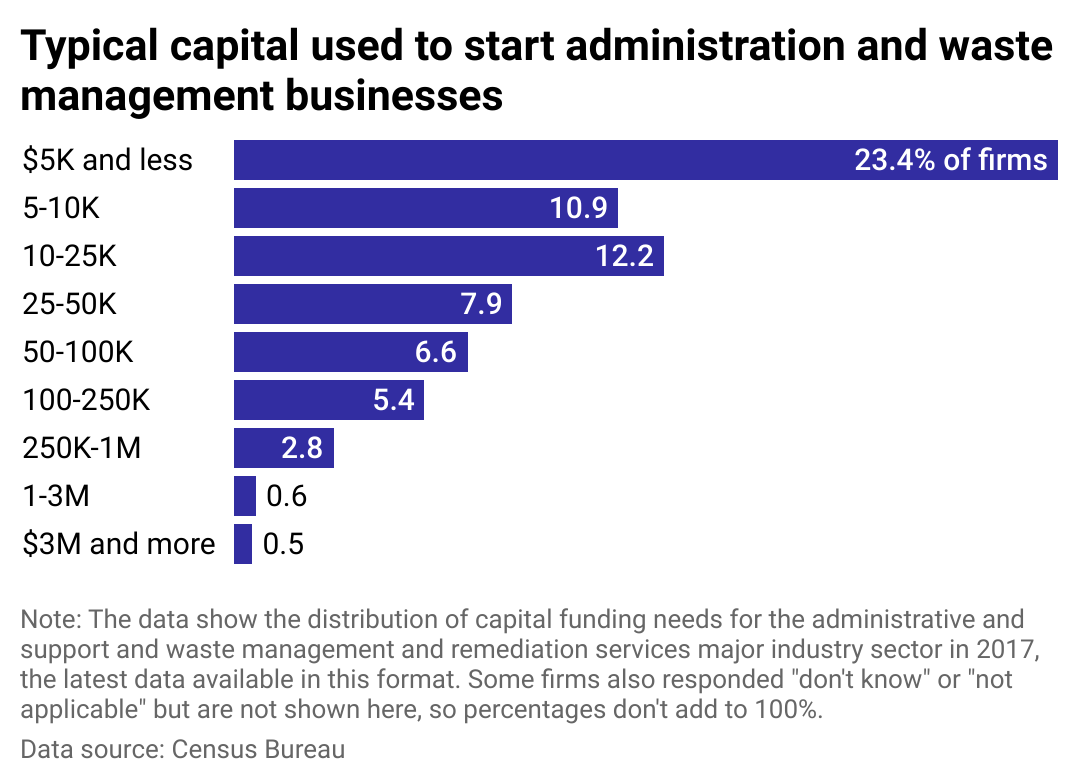
altLINE
#15. Administrative and support and waste management
– Average capital expenditure per establishment, 2021: $59,720
– Total 2021 capital expenditures industrywide: $44.9 billion
This is a service provider industry that offers routine support for the day-to-day operations of companies and households. Small businesses in this sector may offer office administration, hiring personnel, clerical services, soliciting new business, collecting payments, surveillance, cleaning, and waste disposal. The most common range for startup costs was $5,000 or less, a cost range reported by about 23% of businesses. A brick-and-mortar location will be less important for these businesses because they often provide services at their clients’ locations. But equipment may be expensive.
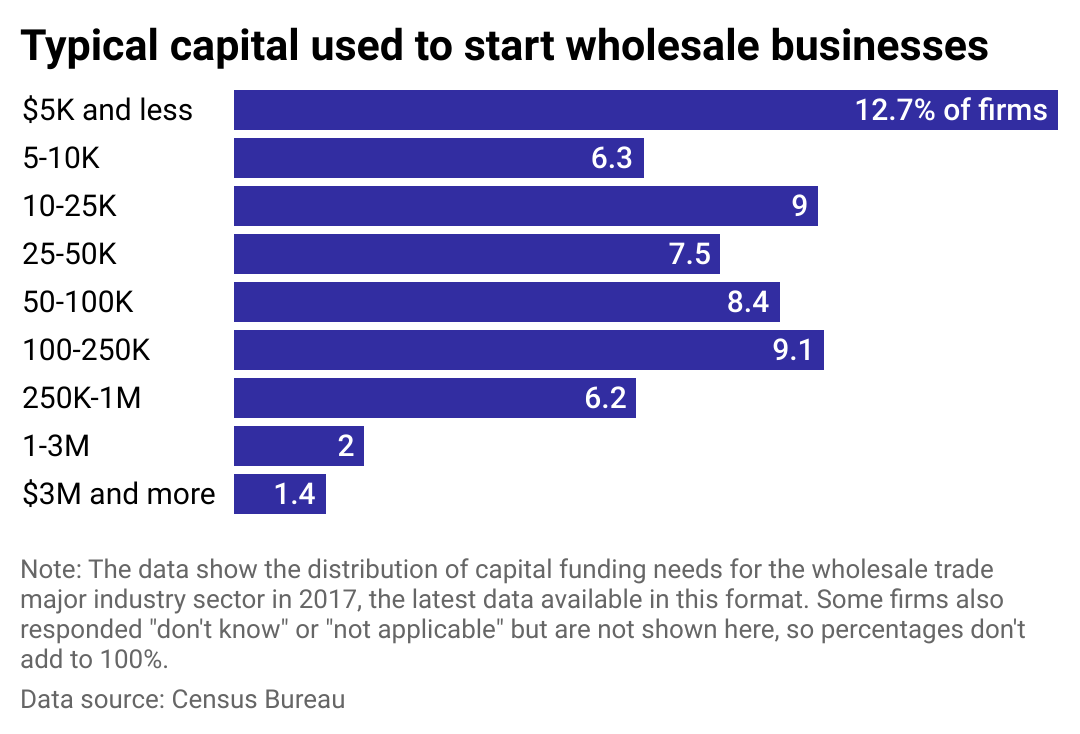
altLINE
#14. Wholesale trade
– Average capital expenditure per establishment, 2021: $103,469
– Total 2021 capital expenditures industrywide: $26.7 billion
Wholesalers sell merchandise to other businesses, and 12.7% reported they started their business with $5,000 or less. Most of the capital expenses are related to purchasing inventory, maintaining warehouse space to store the merchandise, and having vehicles to transport the merchandise. The type and volume of inventory will determine how much capital funding small business owners need to have on hand. More than a specialized license or training, wholesale trade often depends on the owner’s relationships with buyers—and there’s no way to put a price on that when calculating capital expenses.
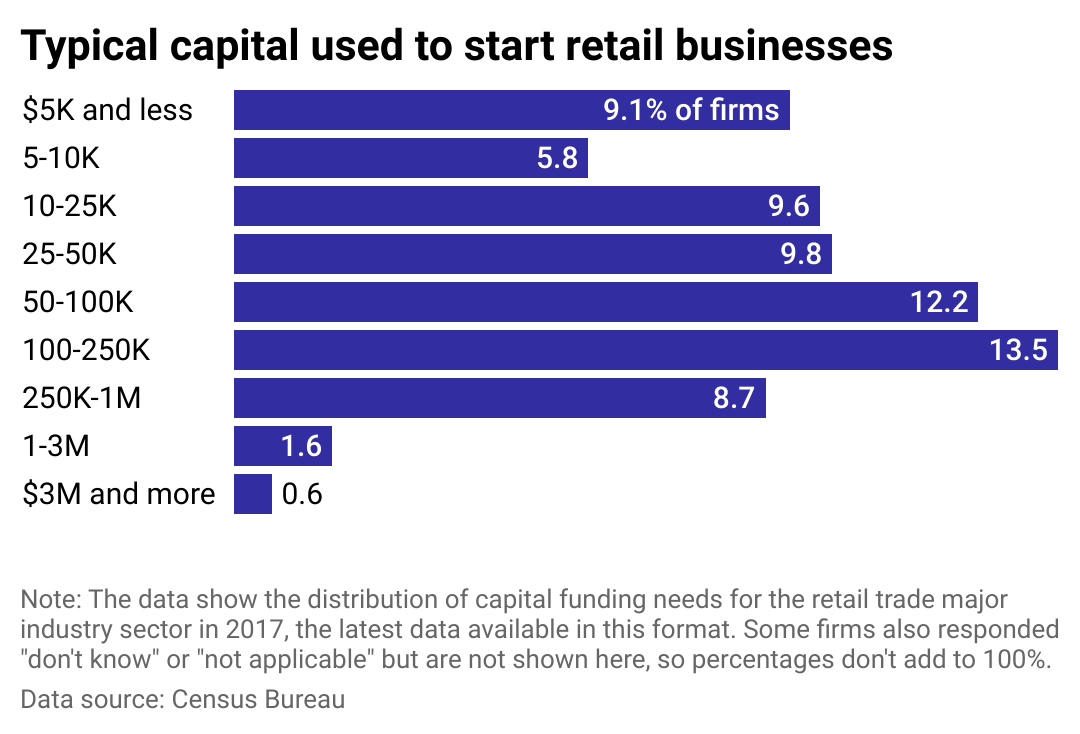
altLINE
#13. Retail trade
– Average capital expenditure per establishment, 2021: $116,051
– Total 2021 capital expenditures industrywide: $40.4 billion
Similar to wholesale trade, inventory is one of the main capital expenses in retail. However, more retailers, 13.5%, reported higher startup costs—in the range of $100,000 to $250,000—than wholesale traders. E-commerce and social media advertising have given many small business owners the option to run their retail businesses entirely online, without a physical location. There are trade-offs in terms of capital expenses. Where brick-and-mortar stores will need to consider real estate costs, online-only businesses will need to invest in sophisticated website design with an online sales system, more digital marketing, and shipping.
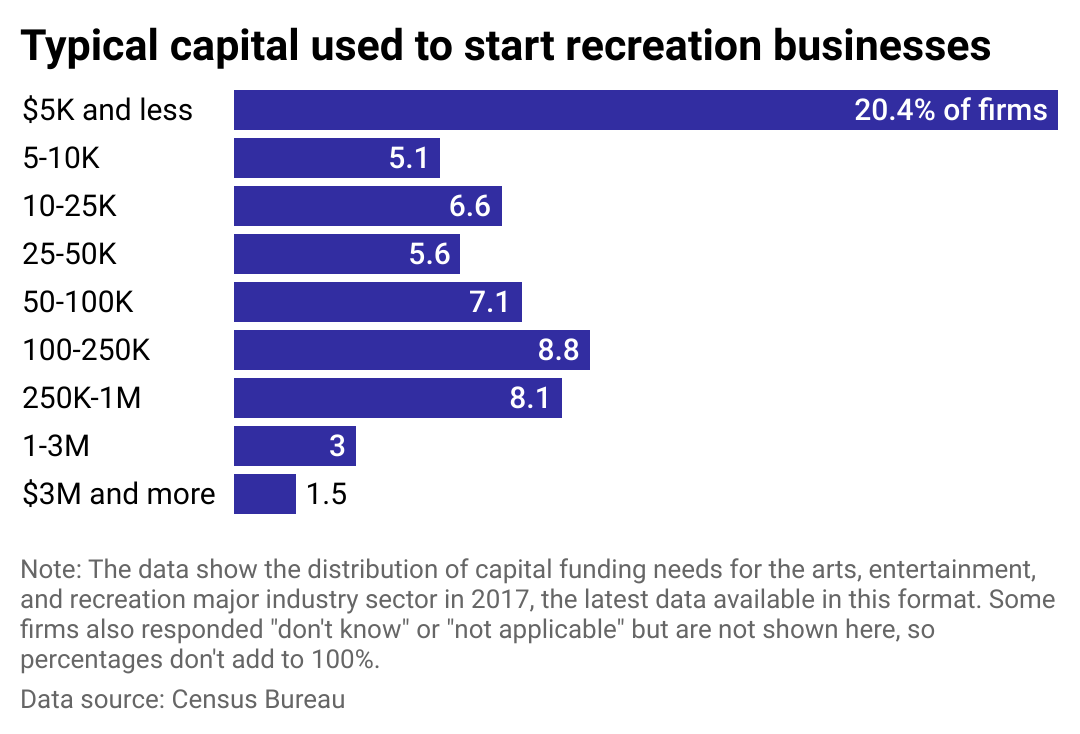
altLINE
#12. Arts, entertainment, and recreation
– Average capital expenditure per establishment, 2021: $118,454
– Total 2021 capital expenditures industrywide: $120.3 billion
Arts, entertainment, and recreation is a wide-ranging industry that runs the gamut from a freelance graphic designer with relatively low startup and capital expenses to a large amusement park requiring much more significant financial investment. Businesses that produce or promote live performances, events, and exhibits; preserve historically, culturally, or educationally significant objects; or offer recreational, amusement, and leisure activities are all part of this industry.
More than 20% of businesses in this industry report startup costs of $5,000 or less. Small business owners should be prepared for capital expenses related to service equipment, as arts and entertainment success often depends on quality customer experiences. Recreational businesses will have more capital expenses related to specialized equipment needed for certain sports and hobbies.
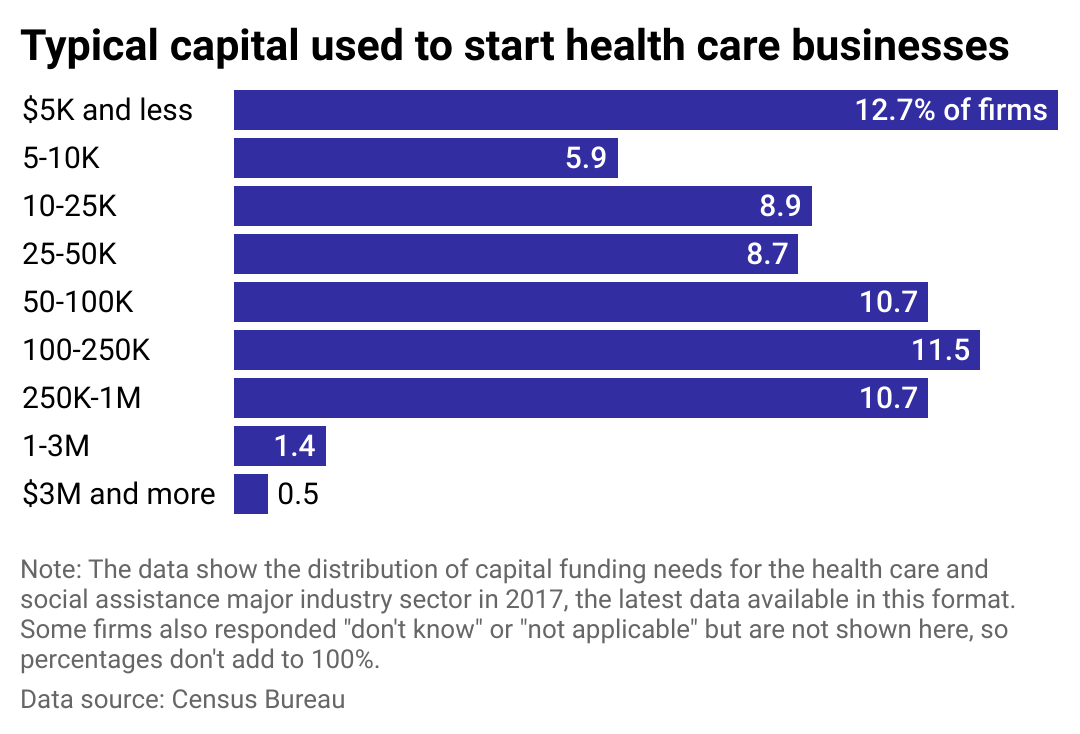
altLINE
#11. Health care and social assistance
– Average capital expenditure per establishment, 2021: $120,186
– Total 2021 capital expenditures industrywide: $18.5 billion
The health care and social assistance industry includes various types of medical practitioners and social workers. Many of these businesses will need brick-and-mortar locations such as hospitals and residential care facilities, which is where capital expenses come in—and they may also need specialized equipment as well. Still, the most common range of startup costs is $5,000 or less, as reported by 12.7% of firms in this industry.
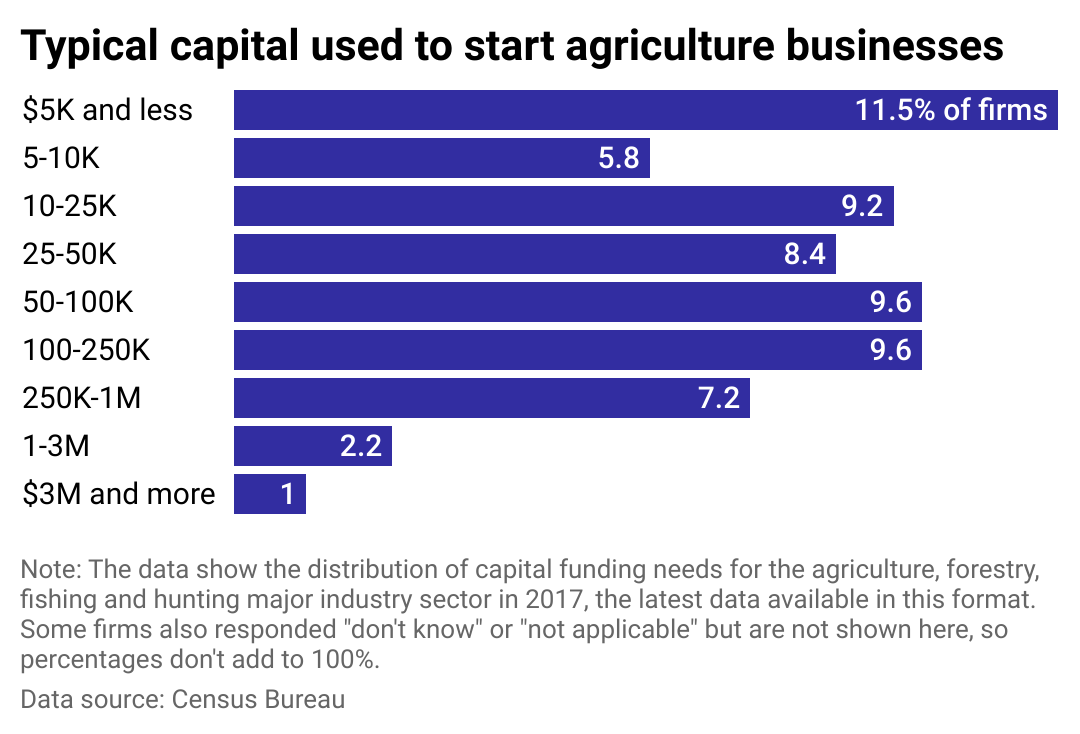
altLINE
#10. Agriculture, forestry, fishing, and hunting
– Average capital expenditure per establishment, 2021: $131,371
– Total 2021 capital expenditures industrywide: $113.9 billion
This industry includes farms, ranches, dairies, greenhouses, nurseries, orchards, and hatcheries. Real estate is a high priority, as the plot of land will determine what type of crop or animal can be raised there. Maintaining the business’s physical location will be a significant capital expense, as will purchasing and maintaining specialized farming equipment. Still, it’s most common for this industry to report startup costs of $5,000 or less, as 11.5% of firms did. Part of the reason for this lower financial barrier to entry is that a significant share of farmland is passed down through families and avoids the typical costs associated with large real estate purchases.
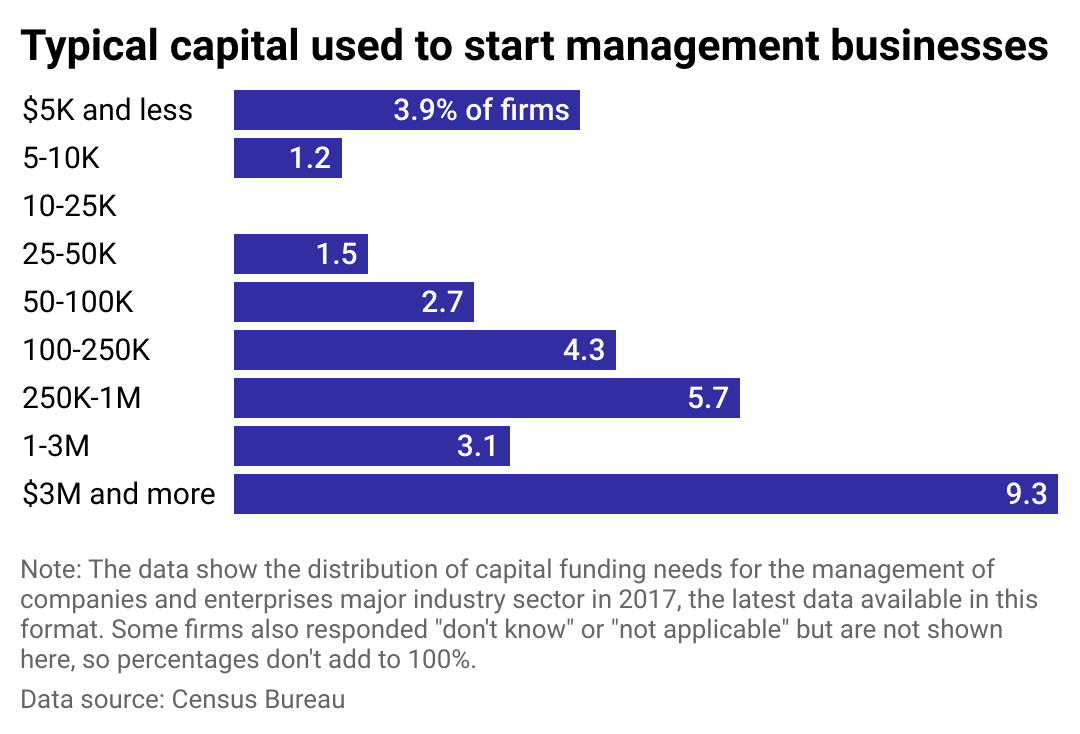
altLINE
#9. Management of companies and enterprises
– Average capital expenditure per establishment, 2021: $156,476
– Total 2021 capital expenditures industrywide: $3.1 billion
Businesses in this industry inform management decisions and handle strategic and organizational planning and decision-making. These service providers are typically hired when companies scale up. Startup costs are often high, with 9.3% of businesses in this industry reporting they spent $3 million or more to launch. Small business owners in this space are more likely to need people—specialized professionals like accountants, bookkeepers, and financial managers—than an office or other capital equipment.
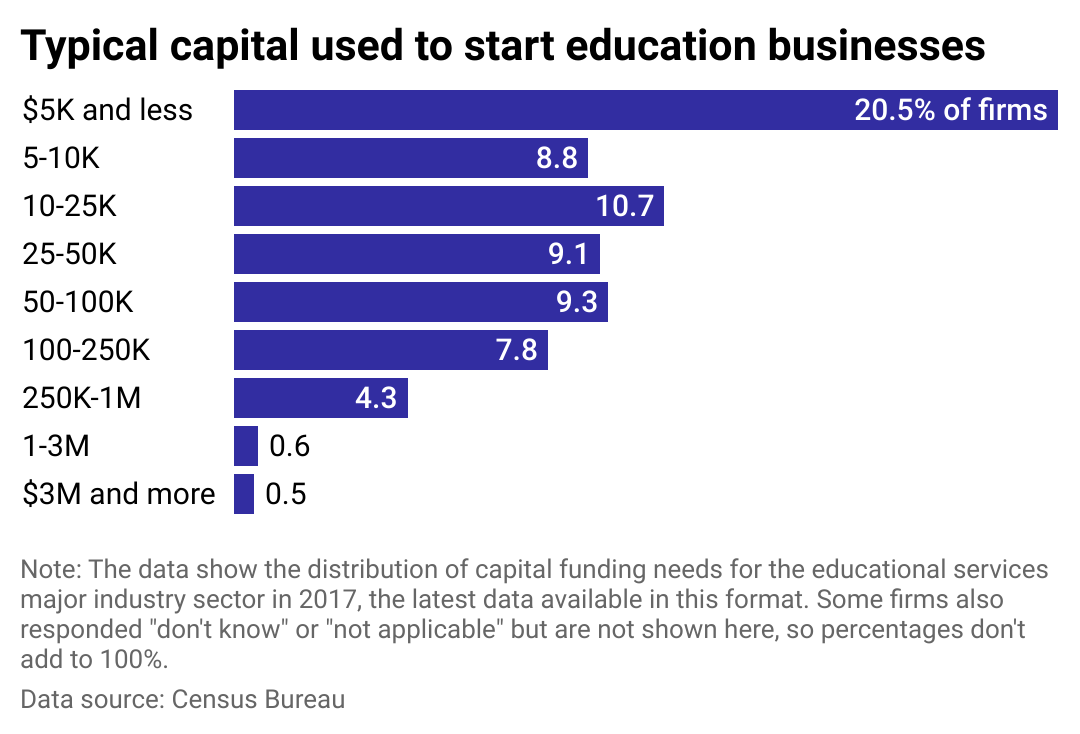
altLINE
#8. Educational services
– Average capital expenditure per establishment, 2021: $258,412
– Total 2021 capital expenditures industrywide: $8.1 billion
Educational services is the first industry in this ranking where average annual capital expenditures exceed the national average for all businesses of $206,383. Schools, colleges, universities, and training centers fall into this category. One-fifth of education businesses report relatively low startup costs of $5,000 or less, which may reflect new online learning opportunities. Schools with a physical location will need to invest in real estate and building maintenance. Education businesses also have significant noncapital expenses, as educators must obtain specialized credentials.
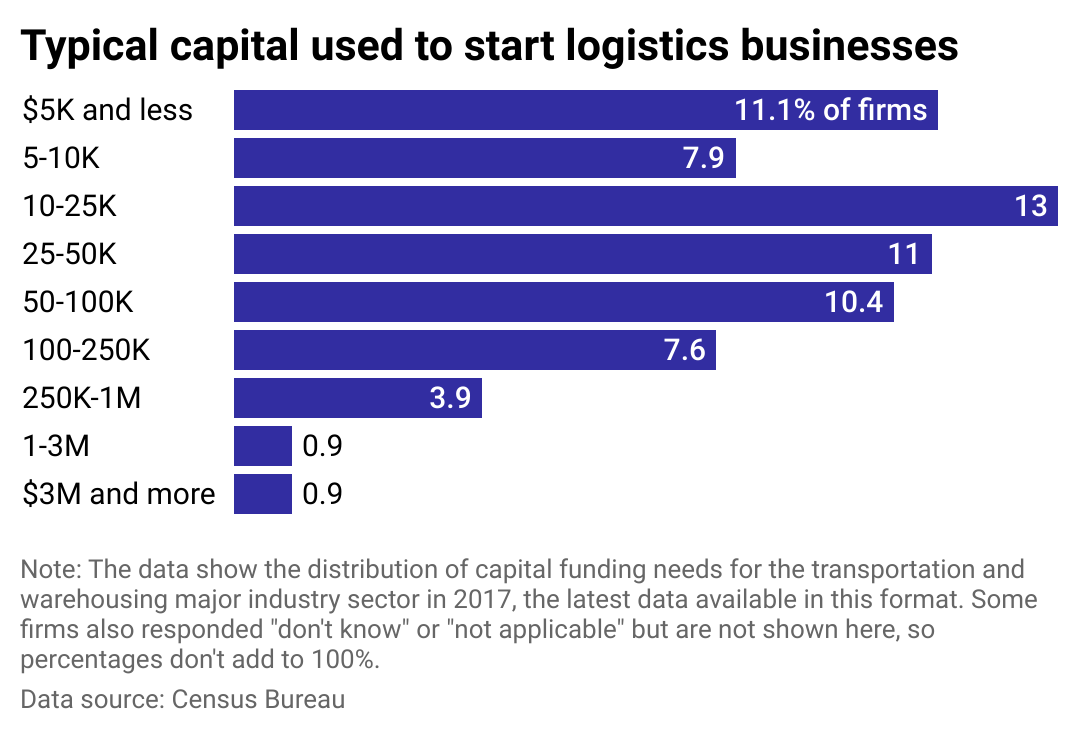
altLINE
#7. Transportation and warehousing
– Average capital expenditure per establishment, 2021: $335,761
– Total 2021 capital expenditures industrywide: $28.8 billion
This industry includes businesses that transport people and cargo, warehouse and store goods, and provide transportation for sightseeing. For transportation companies, a significant capital expense will be purchasing and maintaining a vehicle fleet, whether that’s trucks, cars, planes, boats, trains, or pipelines. Warehouse businesses will need physical space to store goods. Thirteen percent of businesses in transportation and warehousing said their startup costs were between $10,000 and $25,000.
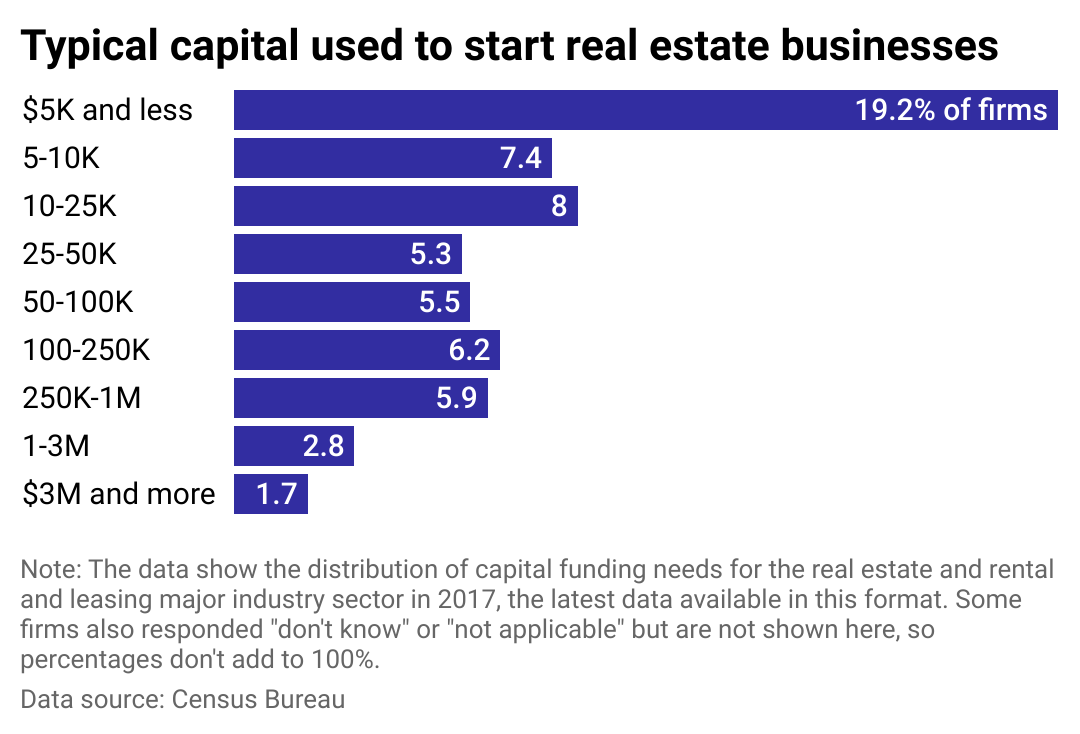
altLINE
#6. Real estate and rental and leasing
– Average capital expenditure per establishment, 2021: $347,041
– Total 2021 capital expenditures industrywide: $93.7 billion
This industry includes professionals who help people buy and rent real estate; businesses that lease vehicles, equipment, and other tangible assets; businesses that lease intangible assets like patents and trademarks; and real estate management companies. Small business owners running a real estate company may have a brick-and-mortar location or connect with clients online, which creates a range of capital funding needs.
Businesses leasing vehicles or equipment should plan on capital expenses related to assembling a fleet of vehicles and carrying insurance that covers the lessees. Businesses leasing intangible assets will likely have lower capital funding needs. Most commonly—for 19.2% of firms in this industry—startup costs are $5,000 or less.
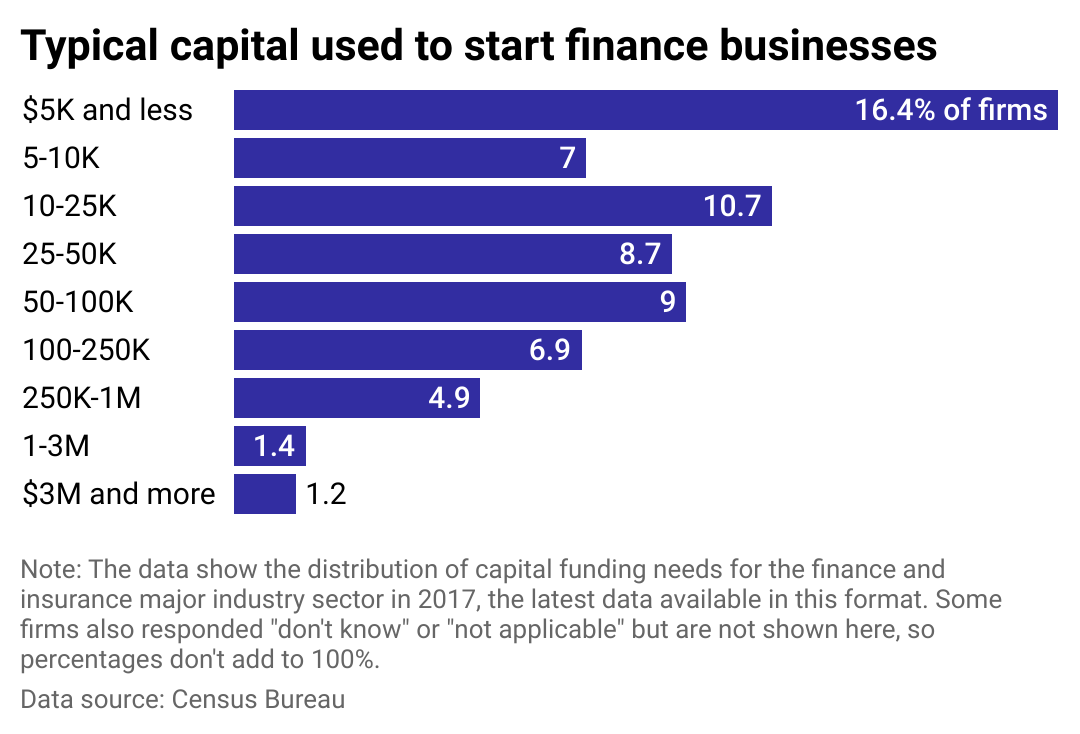
altLINE
#5. Finance and insurance
– Average capital expenditure per establishment, 2021: $363,968
– Total 2021 capital expenditures industrywide: $158.3 billion
Finance and insurance businesses are involved in making loans, purchasing securities, taking deposits, underwriting insurance policies and collecting fees, and providing specialized services related to employee benefits and related financial and insurance needs. Among the financial and insurance businesses, 16.4% of firms say their startup costs were $5,000 and less. Capital funding needs in this industry likely include maintaining a physical location to meet with clients and conduct business.
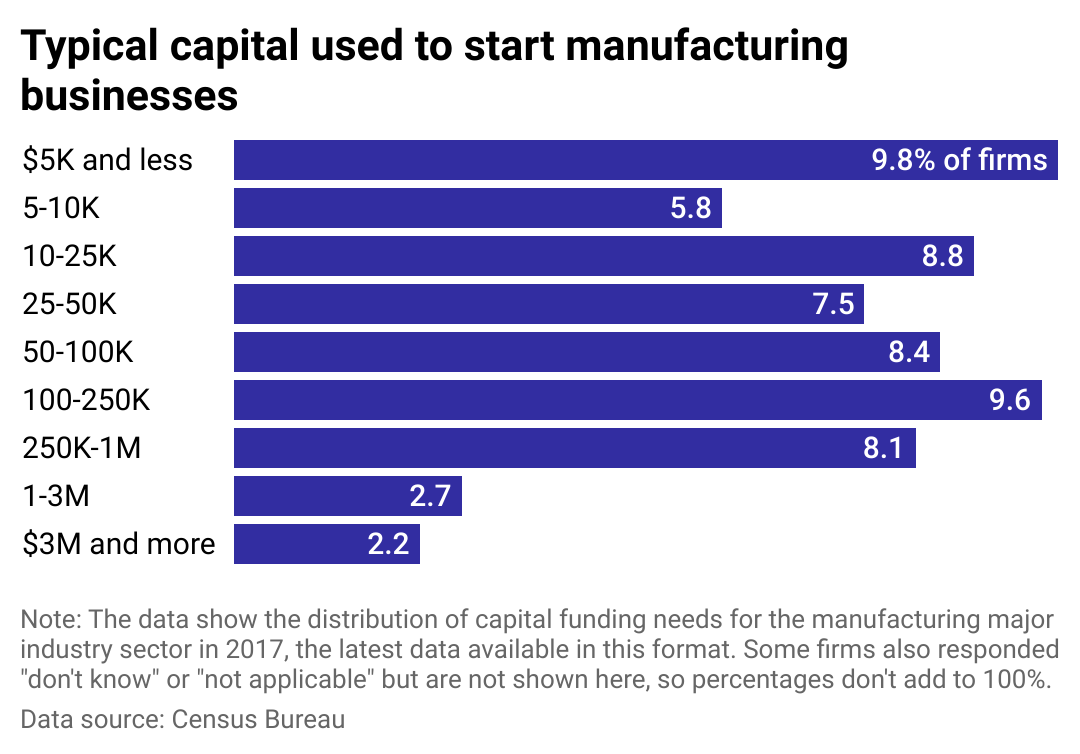
altLINE
#4. Manufacturing
– Average capital expenditure per establishment, 2021: $997,032
– Total 2021 capital expenditures industrywide: $174.3 billion
The manufacturing industry includes any business that transforms materials, substances, or components into new products. This consists of businesses typically associated with manufacturing like plants, mills, and factories as well as bakeries, candy stores, and custom tailors.
The amount of capital funding required to run these types of businesses varies depending on the materials used, the sophistication of the manufacturing process, and the types of machinery required. Nearly 10% of businesses in this industry had startup costs in the range of $100,000 to $250,000 while another nearly 10% had startup costs of $5,000 or less. Whatever the type of business, manufacturers will likely need to invest in a physical location for their business.
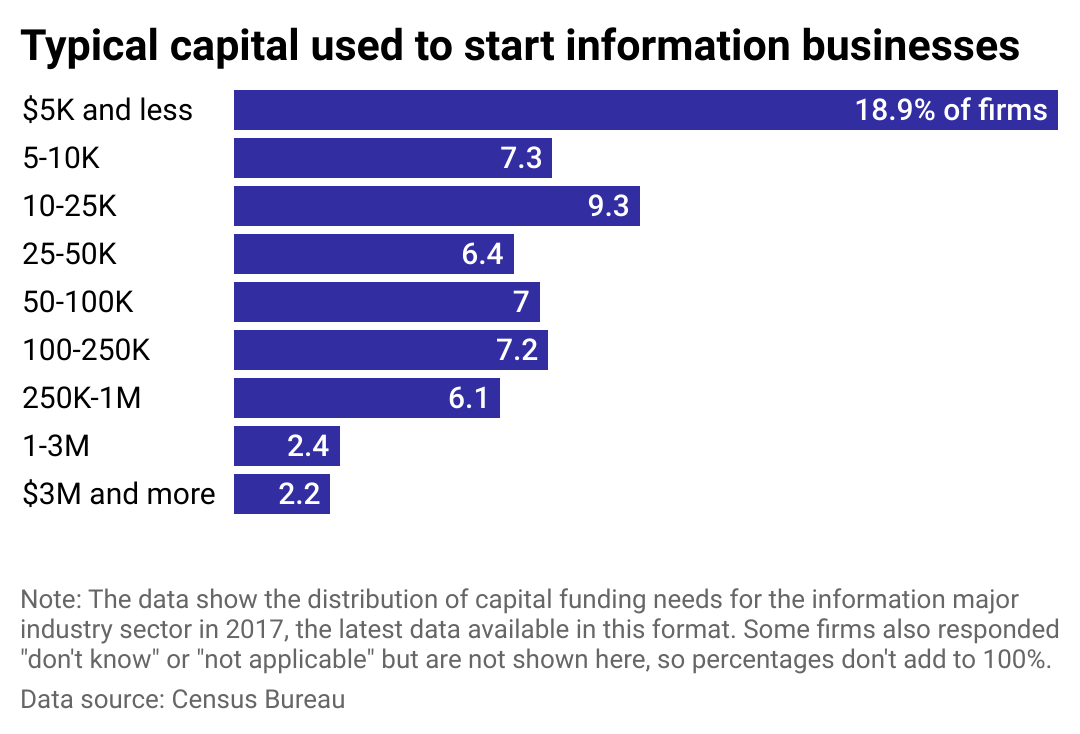
altLINE
#3. Information
– Average capital expenditure per establishment, 2021: $1,200,277
– Total 2021 capital expenditures industrywide: $282.2 billion
The information industry includes software publishing, entities that publish information online, movie production, sound recording, broadcasting, telecommunication, web search portals, data processing, and information services. Much of this work can be done online, so small business owners may not need to spend capital funding on opening a physical location. Significant capital expenses in this industry include building out a communications infrastructure, software licensing, and data security systems. The most common range of startup costs for information firms was $5,000 or less, which was reported by nearly 19% of firms.
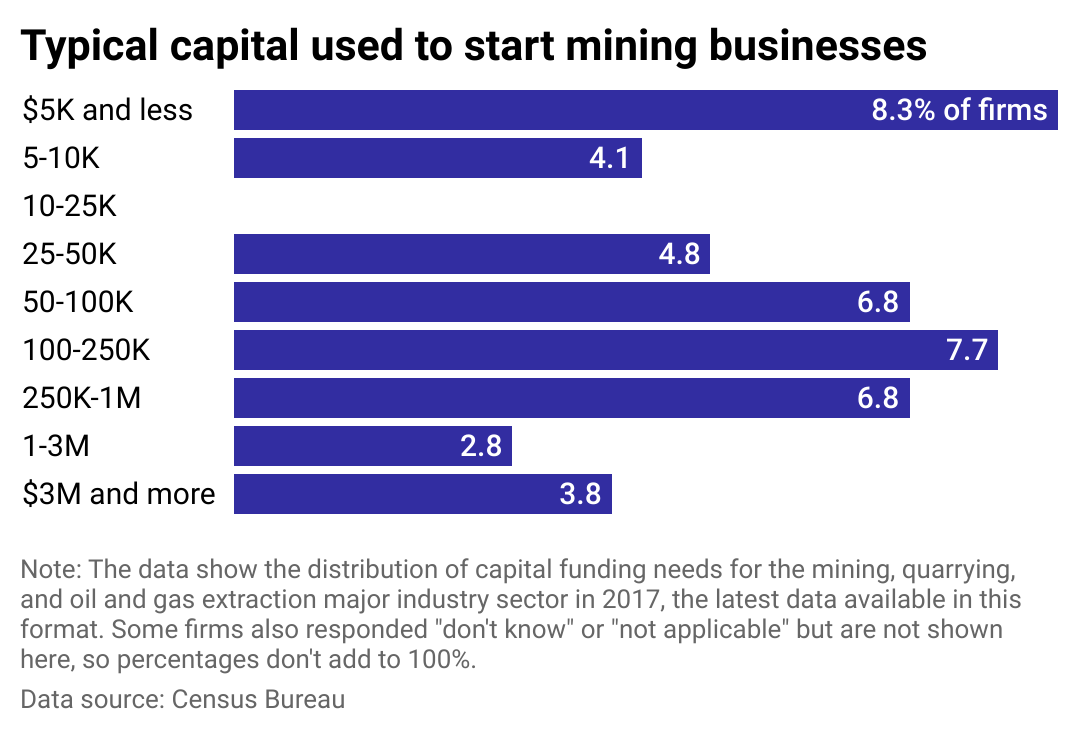
altLINE
#2. Mining
– Average capital expenditure per establishment, 2021: $3,954,703
– Total 2021 capital expenditures industrywide: $194.5 billion
Mining refers to businesses that extract, quarry, and treat minerals and energy sources including coal, gas, and oil. Similar to the agricultural industry, the physical location of these businesses is a top priority as the plot of land will determine how much of a given substance is available for mining. Real estate and specialized equipment are significant capital expenses. Just over 8% of mining businesses launched with $5,000 and less, while another 7.7% spent $100,000 to $250,000 on startup costs. Mining is a risky venture given the high annual capital expenditures combined with the volatile pricing of metals and other mined substances.
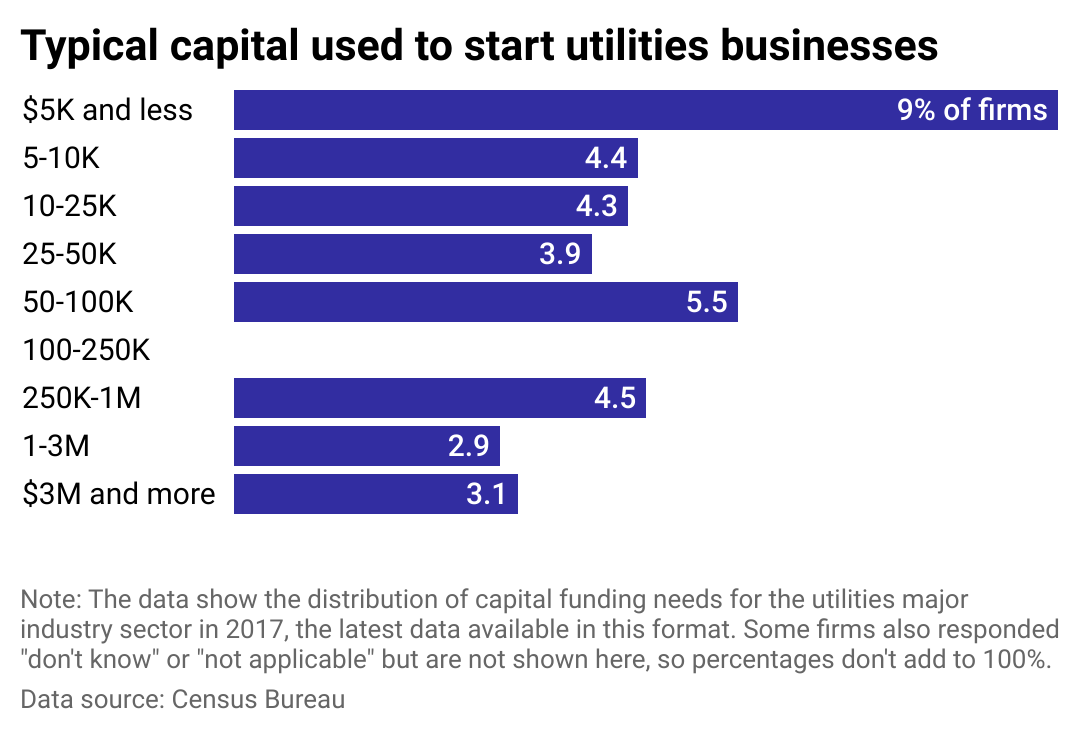
altLINE
#1. Utilities
– Average capital expenditure per establishment, 2021: $8,934,359
– Total 2021 capital expenditures industrywide: $91.1 billion
Utilities have the highest annual average capital expenses. This industry includes companies that provide electrical power, natural gas, steam, water, and sewage removal. Sizable capital expenses are related to the technology and equipment needed to generate the utility and the complex infrastructure needed to deliver it to consumers. In addition, these businesses also need licenses, insurance, and skilled employees to do this work. Capital spending is expected to increase in the coming years as utility companies shift to cleaner energy production.
Data reporting by Paxtyn Merten. Story editing by Jeff Inglis. Copy editing by Tim Bruns.
This story originally appeared on altLINE and was produced and
distributed in partnership with Stacker Studio.
Founded in 2017, Stacker combines data analysis with rich editorial context, drawing on authoritative sources and subject matter experts to drive storytelling.
You may like
Business
Cashiers vs. digital ordering: What do people want, and at what cost?
Published
2 days agoon
April 26, 2024
You walk into a fast-food restaurant on your lunch break. You don’t see a cashier but instead a self-service kiosk, a technology that is becoming the new norm in eateries across the country. The kiosks usually offer customers a menu to scroll through and pictures of meals and specials with prompts to select their food and submit their payment in one place.
Self-service kiosks are big business. In fact, the market for self-service products is expected to grow from a $40.3 billion market value in 2022 to $63 billion by 2027, according to a report from BCC Research. Consumers do have mixed opinions about the kiosks, but about 3 out of 5 surveyed consumers reported that they were likely to use self-service kiosks, according to the National Restaurant Association. The technology, while expensive, can boost businesses’ bottom lines in the long run.
Task Group summarized the rise in digital ordering over the past couple of years, its acceptance among customers, and a cost analysis of adopting the technology.
Self-service kiosks—digital machines or display booths—are generally placed in high-traffic areas. They can be used for different reasons, including navigating a store or promoting a product. Interactive self-service kiosks in particular are meant for consumers to place orders with little to no assistance from employees.
The idea of kiosks isn’t new. The concept of self-service was first introduced in the 1880s when the first types of kiosks appeared as vending machines selling items like gum and postcards. In the present age of technology, the trend of self-service has only grown. Restaurants such as McDonald’s and Starbucks have already tried out cashierless technology.
From a business perspective, the kiosks offer a huge upside. While many employers are looking for workers, they’re having a hard time finding staff. In the midst of the COVID-19 pandemic, employers struggled with a severe employee shortage. Since then, the problem has continued. In 2022, the National Restaurant Association reported that 65% of restaurant operators didn’t have enough workers on staff to meet consumer demand. With labor shortages running rampant, cashierless technology could help restaurants fill in for the lack of human employees.
The initial investment for the kiosks can be high. The general cost per kiosk is difficult to quantify, with one manufacturer estimating a range of $1,500 to $20,000 per station. However, with the use of kiosks, restaurants may not need as many cashiers or front-end employees, instead reallocating workers’ time to other tasks.
In May 2022, the hourly mean wage for cashiers who worked in restaurants and other eating establishments was $12.99, according to the Bureau of Labor Statistics. Kiosks could cost less money than a cashier in the long run.
But how do the customers themselves feel about the growing trend? According to a Deloitte survey, 62% of respondents report that they were “somewhat likely” to order from a cashierless restaurant if given the chance to do so. The same survey reported that only 19% of respondents had experience with a cashierless restaurant.
What would it mean for society if restaurants did decide to go completely cashierless? Well, millions of positions would likely no longer be necessary. One report suggests 82% of restaurant positions could be replaced by robots, a prospect making automation appealing to owners who can’t find staff to hire.
Due to the ongoing labor shortage, employers have tried raising employee wages. Papa John’s, Texas Roadhouse, and Chipotle were among the restaurant companies that increased employee pay or offered bonuses in an attempt to hire and retain more workers. Meanwhile, some companies have decided to use technology to perform those jobs instead, so that they wouldn’t have to put effort into hiring or focus their existing staff on other roles.
Story editing by Ashleigh Graf and Jeff Inglis. Copy editing by Tim Bruns.
![]()
Founded in 2017, Stacker combines data analysis with rich editorial context, drawing on authoritative sources and subject matter experts to drive storytelling.

It’s well-documented that the surest, and often best, return on investments comes from playing the long game. But between stocks and real estate, which is the stronger bet?
To find out, financial planning firm Wealth Enhancement Group analyzed data from academic research, Standard and Poor’s, and Nareit to see how real estate compares to stocks as an investment.
Data going back to 1870 shows the well-established power of real estate as a powerful “long-run investment.” From 1870-2015, and after adjusting for inflation, real estate produced an average annual return of 7.05%, compared to 6.89% for equities. These findings, published in the 2019 issue of The Quarterly Journal of Economics, illustrate that stocks can deviate as much as 22% from their average, while housing only spreads out 10%. That’s because despite having comparable returns, stocks are inherently more volatile due to following the whims of the business cycle.
Real estate has inherent benefits, from unlocking cash flow and offering tax breaks to building equity and protecting investors from inflation. Investments here also help to diversify a portfolio, whether via physical properties or a real estate investment trust. Investors can track markets with standard resources that include the S&P CoreLogic Case-Shiller Home Price Indices, which tracks residential real estate prices; the Nareit U.S. Real Estate Index, which gathers data on the real estate investment trust, or REIT, industry; and the S&P 500, which tracks the stocks of 500 of the largest companies in the U.S.
High interest rates and a competitive market dampened the flurry of real-estate investments made in the last four years. The rise in interest rates equates to a bigger borrowing cost for investors, which can spell big reductions in profit margins. That, combined with the risk of high vacancies, difficult tenants, or hidden structural problems, can make real estate investing a less attractive option—especially for first-time investors.
Keep reading to learn more about whether real estate is a good investment today and how it stacks up against the stock market.
![]()

Wealth Enhancement Group
Stocks and housing have both done well
REITs can offer investors the stability of real estate returns without bidding wars or hefty down payments. A hybrid model of stocks and real estate, REITs allow the average person to invest in businesses that finance or own income-generating properties.
REITs delivered slightly better returns than the S&P 500 over the past 20-, 25-, and 50-year blocks. However, in the short term—the last 10 years, for instance—stocks outperformed REITs with a 12% return versus 9.5%, according to data compiled by The Motley Fool investor publication.
Whether a new normal is emerging that stocks will continue to offer higher REITs remains to be seen.
This year, the S&P 500 reached an all-time high, courtesy of investor enthusiasm in speculative tech such as artificial intelligence. However, just seven tech companies, dubbed “The Magnificent 7,” are responsible for an outsized amount of the S&P’s returns last year, creating worry that there may be a tech bubble.
While indexes keep a pulse on investment performance, they don’t always tell the whole story. The Case-Shiller Index only measures housing prices, for example, which leaves out rental income (profit) or maintenance costs (loss) when calculating the return on residential real estate investment.

Wealth Enhancement Group
Housing returns have been strong globally too
Like its American peers, the global real estate market in industrialized nations offers comparable returns to the international stock market.
Over the long term, returns on stocks in industrialized nations is 7%, including dividends, and 7.2% in global real estate, including rental income some investors receive from properties. Investing internationally may have more risk for American buyers, who are less likely to know local rules and regulations in foreign countries; however, global markets may offer opportunities for a higher return. For instance, Portugal’s real estate market is booming due to international visitors deciding to move there for a better quality of life. Portugal’s housing offers a 6.3% return in the long term, versus only 4.3% for its stock market.
For those with deep enough pockets to stay in, investing in housing will almost always bear out as long as the buyer has enough equity to manage unforeseen expenses and wait out vacancies or slumps in the market. Real estate promises to appreciate over the long term, offers an opportunity to collect rent for income, and allows investors to leverage borrowed capital to increase additional returns on investment.
Above all, though, the diversification of assets is the surest way to guarantee a strong return on investments. Spreading investments across different assets increases potential returns and mitigates risk.
Story editing by Nicole Caldwell. Copy editing by Paris Close. Photo selection by Lacy Kerrick.
This story originally appeared on Wealth Enhancement Group and was produced and
distributed in partnership with Stacker Studio.
Founded in 2017, Stacker combines data analysis with rich editorial context, drawing on authoritative sources and subject matter experts to drive storytelling.
Business
5 tech advancements sports venues have added since your last event
Published
1 week agoon
April 19, 2024
In today’s digital climate, consuming sports has never been easier. Thanks to a plethora of streaming sites, alternative broadcasts, and advancements to home entertainment systems, the average fan has myriad options to watch and learn about their favorite teams at the touch of a button—all without ever having to leave the couch.
As a result, more and more sports venues have committed to improving and modernizing their facilities and fan experiences to compete with at-home audiences. Consider using mobile ticketing and parking passes, self-service kiosks for entry and ordering food, enhanced video boards, and jumbotrons that supply data analytics and high-definition replays. These innovations and upgrades are meant to draw more revenue and attract various sponsored partners. They also deliver unique and convenient in-person experiences that rival and outmatch traditional ways of enjoying games.
In Los Angeles, the Rams and Chargers’ SoFi Stadium has become the gold standard for football venues. It’s an architectural wonder with closer views, enhanced hospitality, and a translucent roof that cools the stadium’s internal temperature.
The Texas Rangers’ ballpark, Globe Life Field, added field-level suites and lounges that resemble the look and feel of a sports bar. Meanwhile, the Los Angeles Clippers are building a new arena (in addition to retail space, team offices, and an outdoor public plaza) that will seat 18,000 people and feature a fan section called The Wall, which will regulate attire and rooting interest.
It’s no longer acceptable to operate with old-school facilities and technology. Just look at Commanders Field (formerly FedExField), home of the Washington Commanders, which has faced criticism for its faulty barriers, leaking ceilings, poor food options, and long lines. Understandably, the team has been attempting to find a new location to build a state-of-the-art stadium and keep up with the demand for high-end amenities.
As more organizations audit their stadiums and arenas and keep up with technological innovations, Uniqode compiled a list of the latest tech advancements to coax—and keep—fans inside venues.
![]()
Jeff Gritchen/MediaNews Group/Orange County Register // Getty Images
Just Walk Out technology
After successfully installing its first cashierless grocery store in 2020, Amazon has continued to put its tracking technology into practice.
In 2023, the Seahawks incorporated Just Walk Out technology at various merchandise stores throughout Lumen Field, allowing fans to purchase items with a swipe and scan of their palms.
The radio-frequency identification system, which involves overhead cameras and computer vision, is a substitute for cashiers and eliminates long lines.
RFID is now found in a handful of stadiums and arenas nationwide. These stores have already curbed checkout wait times, eliminated theft, and freed up workers to assist shoppers, according to Jon Jenkins, vice president of Just Walk Out tech.
Billie Weiss/Boston Red Sox // Getty Images
Self-serve kiosks
In the same vein as Amazon’s self-scanning technology, self-serve kiosks have become a more integrated part of professional stadiums and arenas over the last few years. Some of these function as top-tier vending machines with canned beers and nonalcoholic drinks, shuffling lines quicker with virtual bartenders capable of spinning cocktails and mixed drinks.
The kiosks extend past beverages, as many college and professional venues have started using them to scan printed and digital tickets for more efficient entrance. It’s an effort to cut down lines and limit the more tedious aspects of in-person attendance, and it’s led various competing kiosk brands to provide their specific conveniences.
Kyle Rivas // Getty Images
Mobile ordering
Is there anything worse than navigating the concourse for food and alcohol and subsequently missing a go-ahead home run, clutch double play, or diving catch?
Within the last few years, more stadiums have eliminated those worries thanks to contactless mobile ordering. Fans can select food and drink items online on their phones to be delivered right to their seats. Nearly half of consumers said mobile app ordering would influence them to make more restaurant purchases, according to a 2020 study at PYMNTS. Another study showed a 22% increase in order size.
Many venues, including Yankee Stadium, have taken notice and now offer personalized deliveries in certain sections and established mobile order pick-up zones throughout the ballpark.
Darrian Traynor // Getty Images
QR codes at seats
Need to remember a player’s name? Want to look up an opponent’s statistics at halftime? The team at Digital Seat Media has you covered.
Thus far, the company has added seat tags to more than 50 venues—including two NFL stadiums—with QR codes to promote more engagement with the product on the field. After scanning the code, fans can access augmented reality features, look up rosters and scores, participate in sponsorship integrations, and answer fan polls on the mobile platform.
Boris Streubel/Getty Images for DFL // Getty Images
Real-time data analytics and generative AI
As more venues look to reinvigorate the in-stadium experience, some have started using generative artificial intelligence and real-time data analytics. Though not used widely yet, generative AI tools can create new content—text, imagery, or music—in conjunction with the game, providing updates, instant replays, and location-based dining suggestions
Last year, the Masters golf tournament even began including AI score projections in its mobile app. Real-time data is streamlining various stadium pitfalls, allowing operation managers to monitor staffing issues at busy food spots, adjust parking flows, and alert custodians to dirty or damaged bathrooms. The data also helps with security measures. Open up an app at a venue like the Honda Center in Anaheim, California, and report safety issues or belligerent fans to help better target disruptions and preserve an enjoyable experience.
Story editing by Nicole Caldwell. Copy editing by Paris Close. Photo selection by Lacy Kerrick.
This story originally appeared on Uniqode and was produced and
distributed in partnership with Stacker Studio.
Founded in 2017, Stacker combines data analysis with rich editorial context, drawing on authoritative sources and subject matter experts to drive storytelling.
Featured
-

 Business4 months ago
Business4 months agoSkill-based hiring is the answer to labour shortages, BCG report finds
-

 Business5 months ago
Business5 months agomesh conference goes deep on AI, with experts focusing in on training, ethics, and risk
-

 Events3 months ago
Events3 months agoThe Northern Lights Technology & Innovation Forum comes to Calgary next month
-

 People4 months ago
People4 months agoHow connected technologies trim rework and boost worker safety in hands-on industries
-

 Events6 months ago
Events6 months agoTop 5 tech and digital transformation events to wrap up 2023






